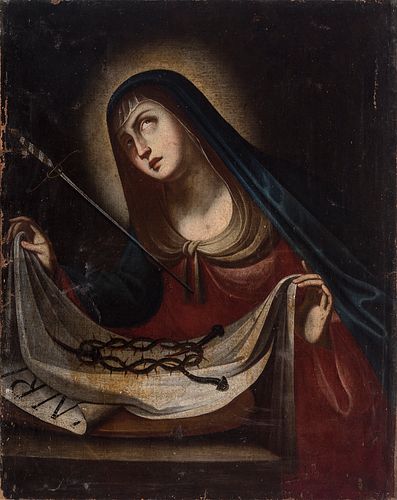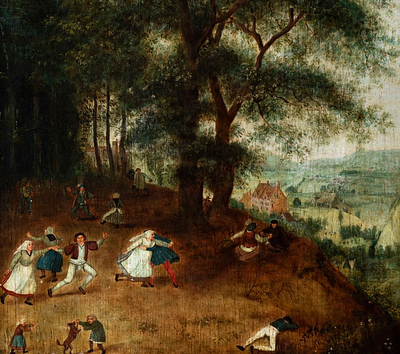Spanish school; 17th century. "Dolorosa with attributes of the Passion." Oil on canvas.
Lot 15
About Seller
Setdart Auction House
Carrer Aragó 346
Barcelona
Spain
Setdart Subastas was born in 2004 and is currently the first online art auction in Spain with solidity, prestige and reliability guaranteed by our more than 60,000 users. Setdart has a young, dynamic and enterprising team ready to successfully manage the purchase and sale of art works through custom...Read more
Estimate:
EUR€1,500 - EUR€2,000
$1,562.50 - $2,083.33
Absentee vs Live bid
Two ways to bid:
- Leave a max absentee bid and the platform will bid on your behalf up to your maximum bid during the live auction.
- Bid live during the auction and your bids will be submitted real-time to the auctioneer.
Bid Increments
| Price | Bid Increment |
|---|---|
| EUR€0 | EUR€10 |
| EUR€200 | EUR€25 |
| EUR€500 | EUR€50 |
| EUR€1,000 | EUR€100 |
| EUR€3,000 | EUR€200 |
| EUR€5,000 | EUR€500 |
| EUR€10,000 | EUR€1,000 |
| EUR€20,000 | EUR€2,000 |
| EUR€50,000 | EUR€5,000 |
About Auction
By Setdart Auction House
Jun 30, 2021
Set Reminder
2021-06-30 08:30:00
2021-06-30 08:30:00
America/New_York
Bidsquare
Bidsquare : Old Masters
https://www.bidsquare.com/auctions/setdart-auction-house/old-masters-7134
Setdart Auction House sofia@setdart.com
Setdart Auction House sofia@setdart.com
- Lot Description
Spanish school; 17th century. "Dolorosa with attributes of the Passion." Oil on canvas. Presents minor faults. Measures: 82 x 65 cm. We see in this painting a devotional image of the Sorrows of the Virgin, with Mary dressed in red, symbolic color of the Passion of Christ, with her chest pierced by a sword that represents her pain, and accompanied by the symbols of the Passion, the nails and the crown of thorns, in addition to the legend where you can read I.N.R.I. Mary holds with both hands a white cloth in whose center is located the crown of thorns, which still retains drops of blood from the face of Christ. The virgin inscribed in a dark background that monumentalizes her figure and contrasts with the warmth of her white face, directs her gaze upwards. This somewhat reflective or imploring attitude brings the faithful, or the observer, closer to the suffering of the Virgin, who is still a mother, gathering the elements of torture of her son. Specifically, it is the theme of the Virgin of Sorrows and Solitude, which presents Mary alone, sometimes with her chest pierced by one or more swords, as we see here. This representation being very close to popular sentiment, the iconography of the Virgin of Sorrows was followed by that of Solitude: Mary, completely alone, is plagued by the memory of the main moments of her life, afflicted in solitude, without her Son. The devotion to the sorrows of the Virgin has its roots in medieval times, and was especially spread by the Servite order, founded in 1233. There are many and varied iconographic representations that have as central theme the Virgin Mary in her Sorrowful aspect, being the first of them in which she appears next to the Child Jesus, who sleeps oblivious to the future of suffering that awaits him. In these works the cross is usually present, the main symbol of the Passion, embraced even by the Child, while Mary observes him with a pathetic expression. Another aspect is the one that is part of the Pietà, similar to the previous one, although her Son is here dead, not asleep, depicted as an adult and after his crucifixion. In the oldest representations of this theme, the body of Christ appears disproportionately small, as a symbol of the memory that the mother has of her Son's childhood, when she contemplated him asleep on her lap. Finally, the Virgin of Sorrows and Solitude also stands out in importance, as can be seen in this work, where Mary appears alone, sometimes with her heart pierced by one or more swords.
- Shipping Info
-
In-house shipping available. Please inquire at admin@setdart.com.
-
- Buyer's Premium



 EUR
EUR CAD
CAD AUD
AUD GBP
GBP MXN
MXN HKD
HKD CNY
CNY MYR
MYR SEK
SEK SGD
SGD CHF
CHF THB
THB

















